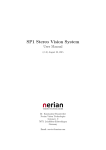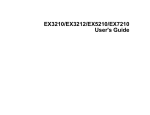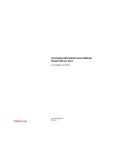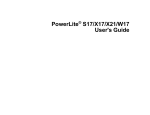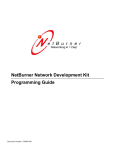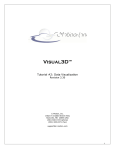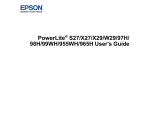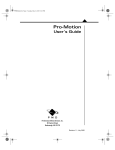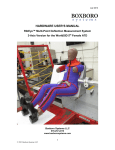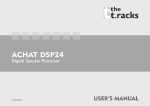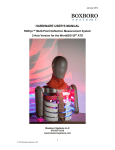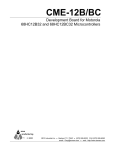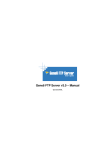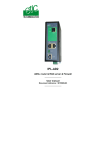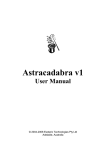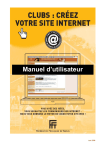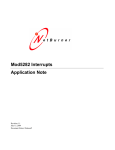Download C-Motion Engine Development Tools Manual
Transcript
C-Motion Engine Development Tools
Manual
®
Performance Motion Devices, Inc.
80 Central Street
Boxborough, MA 01719
Revision 1.2, April 18 2012
NOTICE
This document contains proprietary and confidential information of Performance Motion Devices, Inc., and is protected by federal copyright law. The contents of this document may not be disclosed to third parties, translated, copied,
or duplicated in any form, in whole or in part, without the express written permission of PMD.
The information contained in this document is subject to change without notice. No part of this document may be
reproduced or transmitted in any form, by any means, electronic or mechanical, for any purpose, without the express
written permission of PMD.
Copyright 1998–2012 by Performance Motion Devices, Inc.
Prodigy, Magellan, ION, Magellan/ION, Pro-Motion, C-Motion, and VB-Motion are registered trademarks of
Performance Motion Devices, Inc.
2
C-Motion Engine Development Tools Manual
Warranty
PMD warrants performance of its products to the specifications applicable at the time of sale in accordance with
PMD’s standard warranty. Testing and other quality control techniques are utilized to the extent PMD deems necessary to support this warranty. Specific testing of all parameters of each device is not necessarily performed, except
those mandated by government requirements.
Performance Motion Devices, Inc. (PMD) reserves the right to make changes to its products or to discontinue any
product or service without notice, and advises customers to obtain the latest version of relevant information to verify,
before placing orders, that information being relied on is current and complete. All products are sold subject to the
terms and conditions of sale supplied at the time of order acknowledgement, including those pertaining to warranty,
patent infringement, and limitation of liability.
Safety Notice
Certain applications using semiconductor products may involve potential risks of death, personal injury, or severe
property or environmental damage. Products are not designed, authorized, or warranted to be suitable for use in life
support devices or systems or other critical applications. Inclusion of PMD products in such applications is understood to be fully at the customer's risk.
In order to minimize risks associated with the customer’s applications, adequate design and operating safeguards must
be provided by the customer to minimize inherent procedural hazards.
Disclaimer
PMD assumes no liability for applications assistance or customer product design. PMD does not warrant or represent
that any license, either express or implied, is granted under any patent right, copyright, mask work right, or other intellectual property right of PMD covering or relating to any combination, machine, or process in which such products
or services might be or are used. PMD’s publication of information regarding any third party’s products or services
does not constitute PMD’s approval, warranty or endorsement thereof.
C-Motion Engine Development Tools Manual
3
Related Documents
ION/CME Digital Drive User’s Manual
Complete description of the ION/CME Digital Drive including installation/getting started section, operational overview, detailed connector information, and complete electrical and mechanical specifications.
Prodigy® /CME Stand-Alone Card User’s Guide
Prodigy® /CME PCI User’s Guide
Prodigy® /CME PC/104 User’s Guide
Complete description of the Prodigy/CME motion cards including getting starting section, operational overview, detailed connector information, and complete electrical and mechanical specifications.
Magellan® Motion Processor User’s Guide
Complete description of the Magellan Motion Processor features and functions with detailed theory of its operation.
Magellan® Motion Processor Programmer’s Command Reference
Descriptions of all Magellan Motion Processor commands, with coding syntax and examples, listed alphabetically for quick reference.
PMD Resource Access Protocol Programmer’s Reference
Descriptions of all PRP device commands, with software architecture overview, command syntax, and examples.
Pro-Motion® User’s Guide
User’s guide to Pro-Motion, the easy-to-use motion system development tool and performance optimizer. ProMotion is a sophisticated, easy-to-use program which allows all motion parameters to be set and/or viewed,
and allows all features to be exercised.
4
C-Motion Engine Development Tools Manual
Table of Contents
Chapter 1. Introduction . . . . . . . . . . . . . . . . . . . . . . . . . . . . . . . . . . . . . . . . . . . . . . . . . . . . . . . . . . . . 7
1.1
1.2
1.3
1.4
1.5
1.6
1.7
1.8
C-Motion Engine Device Overview . . . . . . . . . . . . . . . . . . . . . . . . . . . . . . . . . . . . . . . . . . . . . . . . . . . . . . . . . . 7
Introduction. . . . . . . . . . . . . . . . . . . . . . . . . . . . . . . . . . . . . . . . . . . . . . . . . . . . . . . . . . . . . . . . . . . . . . . . . . . . . . . . 7
CME Device Software Overview . . . . . . . . . . . . . . . . . . . . . . . . . . . . . . . . . . . . . . . . . . . . . . . . . . . . . . . . . . . . . 8
Getting Started . . . . . . . . . . . . . . . . . . . . . . . . . . . . . . . . . . . . . . . . . . . . . . . . . . . . . . . . . . . . . . . . . . . . . . . . . . . . . 9
Software Installation. . . . . . . . . . . . . . . . . . . . . . . . . . . . . . . . . . . . . . . . . . . . . . . . . . . . . . . . . . . . . . . . . . . . . . . 10
Programmer’s Notepad . . . . . . . . . . . . . . . . . . . . . . . . . . . . . . . . . . . . . . . . . . . . . . . . . . . . . . . . . . . . . . . . . . . . 11
Downloading the Code . . . . . . . . . . . . . . . . . . . . . . . . . . . . . . . . . . . . . . . . . . . . . . . . . . . . . . . . . . . . . . . . . . . . 14
Executing the Code. . . . . . . . . . . . . . . . . . . . . . . . . . . . . . . . . . . . . . . . . . . . . . . . . . . . . . . . . . . . . . . . . . . . . . . . 15
Chapter 2. Application Development Tools. . . . . . . . . . . . . . . . . . . . . . . . . . . . . . . . . . . . . . . . . 17
2.1
2.2
2.3
Programmer's Notebook. . . . . . . . . . . . . . . . . . . . . . . . . . . . . . . . . . . . . . . . . . . . . . . . . . . . . . . . . . . . . . . . . . . 17
Pro-Motion . . . . . . . . . . . . . . . . . . . . . . . . . . . . . . . . . . . . . . . . . . . . . . . . . . . . . . . . . . . . . . . . . . . . . . . . . . . . . . . . 18
Software Development . . . . . . . . . . . . . . . . . . . . . . . . . . . . . . . . . . . . . . . . . . . . . . . . . . . . . . . . . . . . . . . . . . . . 19
Appendix A. – Copyright Notices
C-Motion Engine Development Tools Manual
v
This page intentionally left blank.
vi
C-Motion Engine Development Tools Manual
1.Introduction
1.1
1
C-Motion Engine Device Overview
Several products in the Prodigy family of Motion Control Cards and the ION family of digital drives provide a programmable C-Motion Engine (CME), which allows user application code to be run in a motion control device instead of on
a host computer.
The following table summarizes the PMD products incorporating a CME, and their associated Users Guide documentation.
Prodigy P/N
PR8358x20
PR9358x20
PR13x58x20
DD3x1S0-056/15
Product Type
Card
Card
Card
Digital Drive
Bus/Format
PC/104
PCI
Stand-Alone
Ethernet/Serial
User Guide
Prodigy/CME PC/104 User’s Guide
Prodigy/CME PCI User’s Guide
Prodigy/CME Stand-Alone Card User’s Guide
ION/CME User’s Guide
In this manual all Prodigy cards or ION digital drives that include a C-Motion Engine will collectively be called CME
devices.
1.2
Introduction
This manual documents the C-Motion Engine Development Tools (also referred to as CME Development Tools),
provided with CME devices, that allow user application code to be created and compiled on a host PC, and then
downloaded, executed, and monitored on the CME device’s C-Motion Engine module.
The C-Motion Engine Development Tools provides the following features:
•
Complete toolset for creation of user-specific applications running on the motion card
•
Open source compiler & motion control C libraries
•
Interactive Development Environment
•
Supports PCI bus, PC/104 bus, RS232/RS485, CANbus, and Ethernet communications
The CME Development Tools includes the following major elements:
•
Programmer’s Notepad source code editor
•
Open source C language compiler & linker
•
PMD C language motion control and C-Motion Engine binary libraries
•
PMD C language motion control and C-Motion Engine libraries in source form for host-based
applications.
•
PMD Pro-Motion application which is used for code management & monitoring
These tools, utilized together, allow a user to quickly and easily develop applications that will run on a device equipped
with a C-Motion Engine.
C-Motion Engine Development Tools Manual
7
1
Introduction
The remainder of this chapter, section 1.3 and beyond, provides a convenient ‘Getting Started’ guide that introduces
the major elements of the C-Motion Engine Development Tools, and takes the user through installation of the
development tools, loading of a simple example program, compilation and linking of that program, and downloading
and execution of that example program.
1.3
CME Device Software Overview
Four major software packages are provided with the CME devices:
Pro-Motion®, an interactive Windows-based exerciser & software development tool
C-Motion®, a C-language library for Magellan Motion Processors that allows you to create motion applications using
the C programming language
VB-Motion®, a dynamic link library (DLL) callable from many dynamic languages and source code for using the DLL
with Microsoft Visual Basic.
C-Motion® Engine Development Tools, a set of development resources that allow you to create, download, and
monitor programs loaded in the CME device’s C-Motion Engine
Here is more information on each of these software packages:
1.3.1
Pro-Motion
Pro-Motion is a sophisticated, easy-to-use exerciser program which provides support for C-Motion Engine code
development, and general purpose motion system setup and exerciser functions. The Pro-Motion features include:
•
•
C-Motion Engine Functions:
•
C-Motion Engine console window function
•
C-Motion Engine user application code download
•
Interactive C-Motion Engine code execution and monitoring functions
General Purpose Functions:
•
Axis Wizard to automate axis setup and configuration
•
High performance motion oscilloscope
•
Interactive DC brush and brushless DC tuning
•
Device window for configuring PMD card and digital drive products
•
Project window for accessing motion resources and connections
•
Ability to save and load current settings
•
Distance and time units conversion
•
Motion network setup & management tools
Pro-Motion is described in more detail in the Pro-Motion® User’s Guide.
8
C-Motion Engine Development Tools Manual
Introduction
1.3.2
1
C-Motion
C-Motion provides a convenient set of callable routines for controlling the Magellan Motion Processor, whether
running on a separate host computer such as a PC, or running on the CME device in the C-Motion Engine. C-Motion,
which is provided as source code, includes the following features:
•
Magellan axis virtualization
•
Ability to communicate to multiple PMD motion cards or modules
•
Ability to communicate via PCI bus, PC/104 bus, serial, CANbus, or Ethernet
•
Provided as source code, allowing easy compilation & porting to various run-time environments
including PC, microprocessor, embedded card, or C-Motion Engine
•
Can be easily linked to any C/C++ application
C-Motion is described in more detail in the Magellan® Motion Processor Programmer’s Command Reference.
1.3.3
VB Motion
VB-Motion provides a complete set of methods and properties for developing applications in Visual Basic and other
.NET languages. VB-Motion includes the following features:
•
Magellan axis virtualization
•
Ability to communicate to multiple PMD motion cards or Modules
•
Ability to communicate via PCI bus, PC/104 bus, serial, CANbus, or Ethernet
•
Provided as a DLL and VB source code for easy porting onto various PC environments
VB Motion is documented in the PMD REsource Access Protocol Programmer’s Reference.
1.3.4
C-Motion Engine Development Tools
The C-Motion Engine Development Tools includes a source code editor, compiler, linker, and Pro-Motion-based code
management & monitoring tools that allow the user to quickly and easily develop applications that will run on a device
equipped with a C-Motion Engine. The C-Motion Engine Development Tools includes the following features:
1.4
•
Complete toolset for creation of user-specific applications running on the motion card
•
Open source compiler and C libraries
•
Interactive Development Environment
•
Supports PCI bus, PC/104 bus, RS232/RS485, CANbus, and Ethernet communications
Getting Started
The next several sections of this chapter will provide an example code development session that illustrates the basic
elements of the CME Development Tools, and provide a foundation for developing your own application for
execution on a C-Motion Engine.
C-Motion Engine Development Tools Manual
9
1
Introduction
This sequence is designed to work with a CME device that has already been connected and initialized to a host PC
using the default Pro-Motion communication scheme, and the default console communication scheme for that device
type. The following table shows the default Pro-Motion and console connectivity that the device should be set to while
using this tutorial, for four types of CME devices:
CME device type
Prodigy/CME Stand-Alone
Pro-Motion
connectivity to PC
Ethernet
Console
connectivity
Serial 2
Prodigy/CME PCI
PCI bus
PCI bus
Prodigy/CME PC/104
Ethernet
Serial 2
ION/CME
Ethernet
None
Power & cabling
Power, Ethernet, and Serial 2
connectivity provided via
cable connections
Card located inside PC,
power & connectivity
through PCI bus
Power, Ethernet, and Serial 2
connectivity provided via
cable connections
Power, Ethernet, and Serial
connectivity provided via
cable connections
Although it is possible to change both the standard Pro-Motion communication port (the port that will send and
receive PRP messages to/from the CME device), and the console port (the destination of printf and similar messages
sent from the C-Motion Engine), for simplicity this getting started tutorial will assume the connections indicated in
the table above.
Note that for Prodigy/CME Stand-Alone and Prodigy/CME PC/104 cards that were set up using the standard User
Guide 'getting started' connection scheme, this means that the Serial 2 port must be connected. This is accomplished
using the convenient two-port (Serial 1 and Serial 2) “Y” serial splitter cable provided with the developer's kit version
of the cards. For more information on card installation, configuration, and initialization, see the appropriate Prodigy/
CME User Guide for the card type that you are using.
1.4.1
Tutorial Sequence Summary
From a host PC that is connected using the communication scheme described above to a properly initialized CME
device, here is a summary of the steps that will comprise this C-Motion Engine Development Tools ‘getting started’
tutorial:
1
Install the C-Motion Engine Development Tools software package on the PC.
2 Invoke the Programmer’s Notepad application, load the Hello.prj project, and compile and link this
example project.
3 Launch Pro-Motion, and download the Hello project binary file to the CME device’s C-Motion Engine.
4 Begin C-Motion Engine code execution, and monitor results on the console window.
Once these steps have been accomplished, the tutorial is complete.
1.5
Software Installation
Before installing the C-Motion Engine Development Tools software, check that your host PC has the following
recommended hardware configuration:
•
10
Intel (or compatible) processor, Pentium or better, 300 MB of available disk space, 256MB of available
RAM, and a CD-ROM drive. The supported PC operating systems are Windows XP, Windows 7, and
Windows Vista.
C-Motion Engine Development Tools Manual
Introduction
1
Two CD-ROMs comprise the software distribution for CME devices. All software applications are designed to work
with Windows XP, Windows 7, or Windows Vista.
•
Pro-Motion: The Pro-Motion disk is located in its own Pro-Motion box, and contains the software
associated with the Pro-Motion Optimized Motion System Development software. This installation
procedure will assume that Pro-Motion has already been installed as part of the general card installation
and setup as described in the Prodigy/CME PCI User’s Guide or the ION/CME User’s Manual. If ProMotion is not yet installed on the host PC you will be using for code development, see the User Guide
for your card for instructions on installing.
•
PMD CME SDK: The PMD CME SDK disk is separate, and contains the C-Motion Engine
development tools, the C-Motion source libraries, and VB-Motion Libraries.
To install the PMD CME SDK:
1
Insert the PMD CME SDK disk into the CD-ROM drive of your computer.
•
If autorun is enabled, the installation process will begin when the CD-ROM is inserted.
•
If autorun is not enabled, go to the next step.
2 On the Start menu, click Run.
3 In the Open text box, type D:\setup.exe.
where D: is the drive letter of your computer’s CD-ROM drive.
4 Follow the on-screen prompts to complete the installation process.
Upon completion of the installation process for Pro-Motion and PMD CME SDK, the following components will be
installed:
•
Programmer’s Notepad application
•
GNU compiler, linker, C libraries, make utility
•
Example code projects
•
C-Motion – source code which may be used for developing motion applications in C/C++ based on the
Magellan Motion Processor.
•
VB-Motion – DLL and example source code which may be used for developing motion applications in
Visual Basic based on the Magellan Motion Processor.
•
PDF versions of the Prodigy/CME PCI User’s Guide, ION/CME User’s Manual, PMD Resource Access Protocol
Programmer’s Reference, C-Motion Engine Development Tools, Magellan Motion Processor Programmer’s Command
Reference, and Magellan Motion Processor User’s Guide. The Adobe Acrobat Reader is required for viewing
these files. If the Adobe Acrobat Reader is not installed on your computer, it may be freely downloaded
from http://www.adobe.com.
1.6
Programmer’s Notepad
Programmer’s Notepad is the primary application by which user application code development projects are loaded,
edited, compiled, and linked.
To continue the tutorial, execute these steps:
1
On the Start menu (in the lower left of the Windows desktop), click All Programs, PMD Prodigy CME
SDK, and then C-Motion CME Code Examples.
C-Motion Engine Development Tools Manual
11
1
Introduction
The Programmer’s Notepad starts, with the project group that contains examples. The following Figure 1-1 shows the
resultant view.
Figure 1-1:
Programmer’s
Notepad
Starting Screen
The project pane to the left shows the various available example projects.
2 Right-click the Hello project icon, which is the ‘root’ icon for the Hello project above the detailed files
that comprise the project (Hello.c, etc.), and then in the dialog box that appears, check Active Project.
This Hello project is now loaded, and you can double-click specific files to examine them, including
README, and Hello.c.
3 For the purpose of this tutorial, double-click Hello.c to display the main() file for this project.
12
C-Motion Engine Development Tools Manual
Introduction
1
The contents of the C file appears. Figure 1-2 provides an example screen image.
Figure 1-2:
Programmer’s
Notepad with
Example
Program
Shown
Feel free to use the editor controls to scroll through the source code file. Hello.c is a simple application
intended for execution on the CME device’s C-Motion Engine that:
•
Sends “Hello, world” to the console window.
•
Communicates to various elements on the card, and sends the version information for the CME
device, the C-Motion Engine module, and the card’s Magellan Motion Processor, back to the console
window.
•
Sends the current encoder position of axis #1 of the Magellan Motion Processor to the console
window.
•
Sends updated values of the actual position, once per second, if the actual encoder position changes.
4 To compile and link the application, use the Programmer’s Notepad Tools menu to execute the Make All
function. This function will compile and link the source code for the entire project.
If the compiling and linking occurs without error, the output window at the bottom of the screen will
contain the message ‘Process Exit Code: 0’ toward the bottom of a list of messages that are output as it
is making the binary file image. In addition, a special binary file (also called a bin file) will be created, with
the project name and a “.bin” extension. So in this case the file will be called “Hello.bin”. It is this bin
file that will be downloaded to the CME device C-Motion Engine.
C-Motion Engine Development Tools Manual
13
1
Introduction
If one or more error messages occur, double-clicking on a compiler error with a filename and line number will take
you to the line where the error is reported. You can try to resolve the error, or call PMD for assistance.
New example projects are added to PMD’s CME development tools regularly, so for a complete list of project
examples along with brief descriptions, you can use the File menu and the Open function to look at a README
file in the project list directory. Most directories within the CME development tools contain a README file
which summarizes the contents of that directory.
1.7
Downloading the Code
Once the.bin file has been created, the remaining steps of the development process will occur via Pro-Motion.
A typical development session will involve multiple iterations of code creation, editing, downloading, and execution,
so it may be most convenient to put away (minimize) Programmer’s Notepad, or arrange it within your screen so that
it is available alongside Pro-Motion.
In any case, the following steps are used to continue the tutorial process:
1
Locate the Pro-Motion icon from the PC desktop and launch.
Depending on how Pro-Motion was last used, you may need to click the ‘DEV.’ (short for development
view) icon on the tool bar at the top, right of the application window. Figure 1-3 shows a typical screen
view with Pro-Motion in this view mode.
Figure 1-3:
Pro-Motion
Starting Screen
in Dev.View
14
C-Motion Engine Development Tools Manual
Introduction
1
At the center of the screen you will see the Device Control window. This convenient graphical
representation of the CME device allows you to manage card-level functions. The Console window is to
the bottom. This will show messages output from the C-Motion Engine.
•
Click the C-Motion Engine icon.
A dialog box as shown in Figure 1-4 appears providing various status and version information for the CMotion Engine and information on any user application code file (.bin files) that may be loaded into it.
Figure 1-4:
C-Motion
Engine Dialog
Box
2 In the C-Motion Engine window, use the File To Download window or the Browse button to locate the
“Hello.bin” file (the examples are typically located in the folder “C:\My
Documents\PMD\CMESDK\CMECode”).
3 Click the Download button, and the download (also called Flash) process begins.
4 After a successful flash, the name, user version number, and checksum of the program may be output in
the C-Motion Engine window.
5 An additional dialog box asks you whether you would like to begin executing the code.
1.8
Executing the Code
Upon successfully downloading the Hello.bin file in the steps above, the code is loaded into the C-Motion Engine and
ready to execute. The following instructions complete the process of executing and monitoring code execution on the
C-Motion Engine.
1
From step 4 above, click OK to begin code execution. As shown in Figure 1-5 you should immediately
see a number of console screen messages appear in the window to the bottom of the Pro-Motion screen.
C-Motion Engine Development Tools Manual
15
1
Introduction
Figure 1-5:
Pro-Motion
Console
Window
These message were sent by the C-Motion Engine to the Console window as it executed the downloaded
code. Console messages are special communications that use the standard output stream (stdio) to display
message from the C-Motion Engine.
2 If an encoder is connected to axis #1 of your CME device, turn the encoder and updated actual position
values will be output to the Console window.
This program continues executing indefinitely until you either stop execution, load another .bin file to
the C-Motion Engine, or reset the card.
Congratulations! You have completed the basic ‘Hello, world’ tutorial and can now continue code development by
creating your own projects or expanding on the example projects included with your SDK.
16
C-Motion Engine Development Tools Manual
2.Application Development
Tools
2.1
2
Programmer's Notebook
Programmer’s Notepad is a utility for editing source code and for running build tools. It is included with the Prodigy/
CME developer’s kit software and provides a convenient way of working on the C-Motion Engine (CME) user code
examples, and also on real CME user code applications. Programmer’s Notepad is free software, and may be downloaded
from http://www.pnotepad.org.
The use of Programmer’s Notepad is not required, all CME code building may be done from the command line, or
integrated into some other tool if desired.
2.1.1
Group Organization
Programmer’s Notebook relies on the concept of a project to organize logically related software elements. A project is
a set of files needed to build a program, organized into a unit. Information about a project is saved in a file with a suffix
of “.pnproj.” Project files may be opened by clicking Open Project(s) on the File menu, and may be saved by rightclicking on the project name in the Projects pane and clicking Save Project.
Projects may be collected together into a project group, which may be saved as a file with a suffix of “.ppg.” To make
your own project group, on the File menu, click New, and then Project Group. Projects, either new or existing, may be
added to the project group by right clicking the New Project Group name. To save the project group to disk, on the
File menu, click Save All; you will be prompted for a file in which to save the project group. To use the project group
file, either click Open on the File menu, or start Programmer’s Notepad by clicking the .peg file in an Explorer window.
The individual files in a project are listed below its name in the Projects pane. In order to read or edit a file, double click
on its name, and a window with the file contents will appear in the large file area on the right side of the Programmer’s
Notepad window.
2.1.2
Editing
Using Programmer’s Notepad to edit a file is similar to using Windows Notepad. The arrow keys, or the slider on the
right side of the window, or the page up and down keys may be used to navigate, and text may be inserted at any time
by typing. The Edit menu has a variety of choices for searching through text, cutting and pasting, and manipulating text
in various ways.
2.1.3
Building
In order to build a project, right-click on the project name in the Projects pane, and select Set Active Project. The
project just selected remains “active” until changed; this means that the Tools menu will apply to that project. The Tools
menu is used for building a project – to try building, click Make All on the Tools menu, or press the F7 key.
The pane at the bottom of the window shows the output of the build process, including the process exit code at the end.
An exit code of zero means that the build succeeded, and any other value that it failed. Normally in case of failure some
useful error messages will be shown in the Output pane. When the error messages are compiler errors with file name
and line number information Programmer’s Notepad is smart enough to show exactly where the compiler thinks the
error occurred; just double-click an error message with a file name and line number and a window showing the location
will pop up.
C-Motion Engine Development Tools Manual
17
2
Application Development Tools
In addition to building projects with Make All, Programmer’s Notepad by default can remove all built files by using
the Tools menu option Make Clean. By using the Tools menu option, Options, one can get a window showing
various configuration choices for the Tools menu. The Tools and Project Tools names in the lower part of the
right hand pane allow one to add new entries to the Tools menu, and to edit the Make All and Make Clean entries,
which are found by choosing the Scheme “(None – Global Tools).”
By following the Tools configuration trail, one quickly sees that Make All and Make Clean just call an external program
called “pmdmake.exe,” with appropriate options. pmdmake.exe, is really GNU make, renamed to make it less
likely to conflict with already installed programs. The make utility performs the build by calling the compiler, linker,
and other utilities in a way dictated by the Makefile. Each of the makefiles for the CME device examples uses the same
Makefile in the parent folder, and that Makefile may be used as a starting point for user application projects. Writing
Makefiles is beyond the scope of this manual, but is described in the GNU make documentation, which is included.
2.1.4
Example Projects
There are some example projects already included with the C-Motion Engine Development Tools SDK. In order to
try some of the example CME programs, run Programmer’s Notepad from the Start menu, using the shortcut “CMotion CME Code Examples.” This will bring up a window that lists the CME Code Examples. The collection
of projects that are CME device examples is saved as the file Examples.ppg.
You should notice that each example includes a file called README, which describes what the example does, any
configuration or special hardware that might be required, and so forth.
The examples can be compiled as is, or can be used as the basis of a customized system through further modification.
The examples provided with the C-Motion Development Tools SDK are intended purely for illustration purposes. They are not warranted to be error free, nor are they warranted to be suitable for use in a particular
application. It is up to the user to insure the quality of their developed code.
2.2
Pro-Motion
Pro-Motion is a software prototyping and control tool used for all Magellan family products. Most Pro-Motion
features are described in the Pro-Motion User’s Guide, but features used only with CME devices are described here.
When used with a CME device, Pro-Motion provides a Device Control pane, which may be turned on and off with
the device icon in the left half of the toolbar. The right half of the toolbar includes a Dev (short for development)
icon which may be used to set Pro-Motion to a view that includes the Device Control pane, and other panes useful
for CME code development.
2.2.1
The Console
The CME has the notion of a console, a peripheral used for displaying messages from C-Motion Engine user programs.
This is useful for debugging, reporting progress, and sanity checking.
For Prodigy/CME Stand-Alone and Prodigy/CME PC/104 cards, the second serial channel (Serial 2) is the default
output console channel. For Prodigy/CME PCI cards, the PCI bus is the default console output channel. For ION/
CME, the single serial port is the default console output channel.
To change where the CME device outputs its console information the Console Output box in the Device Control
pane is used. By clicking on this box, you can select one of the options: serial, PCI (for Prodigy/PCI cards), Ethernet
(UDP/IP), or none.
18
C-Motion Engine Development Tools Manual
Application Development Tools
2
Changing these values changes the power up default console settings only, so you must reset the card for these changes
to take effect. This can also be accomplished in the Device Control pane.
To enable Pro-Motion displaying messages on the console window, right-click the CME Console window and select
the console channel that matches what the card uses for console output.
After reset, if a user program is running, then the console shows the output of any PMDprintf, PMDputs, or
PMDputch calls.
2.2.2
Downloading and Running User Programs
The C-Motion Engine in a CME device may be programmed with a single user program at a time, and downloading,
sometimes called “flashing” because the program is stored in flash RAM, may be done using the C-Motion Engine
box in the Device Control pane.
2.3
Software Development
2.3.1
CME Development Software Libraries
C-Motion Engine user programs may use standard C library and math library calls, which are provided by the Red Hat
newlib C library, which is intended specifically for embedded applications. Floating point support is provided in
software, so there is a definite performance penalty for floating point arithmetic when compared to fixed point.
Dynamic memory allocation is supported, using the standard malloc and free calls. Approximately 7 kilobytes of heap
space are available. Because of the possibilities of heap fragmentation and memory leaks in application code it is
strongly recommended that dynamic allocation be kept as static as possible, for example by allocating all necessary
data structures at initialization time.
Standard I/O functions are supported only for the standard output streams stdout and stderr, which are connected
to the console. Because there are no file systems available to CME device user programs there is no way to open a file.
2.3.2
PMD Software Libraries
Almost all operations performed by C-Motion Engine user programs that deal with physical devices and resources are
accomplished using PMD C language libraries.
It may not be obvious at the outset of development exactly which parts of an application should run in the CME and
which on a host computer. In order to make it simpler to change this division of labor, and to allow prototyping of
CME code on a PC, almost all of the PMD library call sequences are the same in both host-based and C-Motion
Engine environments, although the internal details of implementation and data structures differ substantially.
There are several categories of physical device that CME user programs may deal with:
•
Magellan Motion Processors, either the CME device processor, or Magellan attached devices, such as
non-CME ION modules or non-CME Prodigy cards. These are controlled using the PMD C-Motion
library, which is documented in the Magellan Motion Processor Programmer’s Reference. C-Motion uses a
representation of a Motion Processor control axis called an axis handle for all commands. Although the
means of obtaining the axis handle are different for the various Magellan devices, the use of the axis
handle once obtained is identical.
•
Peripheral connections, meaning communication links to off-card devices, using serial, Ethernet,
CANBus, or PC/104 bus channels. Peripheral handling is supported by a PMD C language library which
is used only with CME devices and documented in the PMD Resource Access Protocol Programmer’s Guide.
C-Motion Engine Development Tools Manual
19
2
Application Development Tools
Peripheral connections are represented by a simple peripheral handle object, which may be read or
written. There are special procedures for using peripheral connections to address Magellan attached
devices or other CME devices.
•
2.3.3
Other on-card resources, such as dual-ported RAM, and general purpose digital I/O pins, are accessed
either by using the Prodigy/CME library or C-Motion calls for non-Magellan resources documented in
the Magellan Motion Processor Programmer’s Reference.
User Code Architecture
A CME program is normally in the form of a non-terminating loop, because it must continue doing its job as long as
the CME device is powered. If it is necessary to exit because of an error condition the PMDAbort procedure should
be used.
The C-Motion Engine is a specialized computer that does almost nothing but motion control. This means that a CME
user program may freely use, and rely upon, almost all the resources (memory, processor cycles) available to the CME,
but it also means that the programmer is responsible for not exceeding the limits on any resource. These resources
include:
•
Stack space – deeply nested procedure calls, and large data structures in auto storage should be avoided.
•
Processor cycles – the developer should use timing procedures such as PMDGetTickCount to verify that
each part of an application can run within its time budget. Handling peripheral input and output also
requires processor cycles, so heavy network traffic, particularly Ethernet traffic, may overload the
processors.
•
Data space plus heap space is limited to approximately 7 kilobytes.
•
Heap space is limited to approximately 7 kilobytes. It is suggested that all dynamic allocation be done in
the initialization phase of a user program, so that unexpected allocation failures due to memory leaks or
heap fragmentation do not cause problems.
•
Code space is limited to approximately 256 kilobytes. Fortunately code size limitations can be found at
build time. One of the best ways of reducing code size is to factor code so that the same procedure
performs its task in several places. Cut and paste coding bloats code size.
CME programs require a small amount of boiler plate, specifically the USER_CODE_VERSION and
USER_CODE_TASK macros. USER_CODE_VERSION is used to specify major and minor version numbers for the
user program, but is required even if you don’t care about versioning. It must be used once, at top level (outside any
procedure body). USER_CODE_TASK is used to define the procedure used as the main entry point in the user
program. A skeleton user program might look like this:
#include “usermain.h”
#include “C-Motion.h”
#include “PMDsys.h”
// user program macros, (required).
// C-Motion library calls, for Motion Processor control
// Timing, program control, and console procedures.
#define MAJOR_VERSION 0 // These are for the user, and may be freely chosen.
#define MINOR_VERSION 9
USER_CODE_VERSION(MAJOR_VERSION, MINOR_VERSION) // Required
USER_CODE_TASK(myjob)
20
C-Motion Engine Development Tools Manual
Application Development Tools
2
{
// Get ready to do something useful here.
while (!0) { …
// Do something useful here.
}
}
The first tool for discovering what your user program is doing, and why it might be failing, is the console. Information
on progress, status, and debugging values may be printed using PMDprintf, PMDputs, and PMDputch. Remember
that PMDprintf may not be used to format floating point numbers, instead sprintf using a temporary buffer must be
used.
Another useful diagnostic tool is the set of general purpose digital I/O pins, which may be read or written using the
C-Motion ReadIO and WriteIO procedures as documented in the Prodigy/CME Stand-Alone User’s Guide, Prodigy/
CME PCI User’s Guide, Prodigy/CME PC/104 User’s Guide or ION/CME User’s Manual. With the use of an oscilloscope
these pins can send diagnostic output much faster than the console procedures.
CME user programs may cause processor exceptions, for example, by reading from or writing to illegal addresses, or
by trying to execute illegal instructions, probably because of stack corruption or bad function pointers. An exception
will cause a reset of the entire CME device, because it is impossible to know what data structures were corrupted
before the exception occurred. After the reset some diagnostic information, including the code address of the
exception, register values at the time, and some stack contents, will be printed to the console. This information may
be useful in determining where the program went wrong.
A C-Motion Engine user program has a single thread of control; threading or interrupt handling are not available.
Because of this restriction CME user programs have a very simple model, and semaphores or other locking
mechanisms are not used, which means that almost everything done by a user program must be driven by polled input,
with or without timeouts. The recommended way of structuring a CME user program is as a state machine, which uses
one or more variables to represent an enumerated set of states, and transitions from one state to the next in a way
determined by the inputs read in each state.
C-Motion Engine Development Tools Manual
21
2
Application Development Tools
This page intentionally left blank.
22
C-Motion Engine Development Tools Manual
Appendix A. – Copyright Notices
A.1 Overview
The following sections provide required copyright notifications for the open source software libraries, LWIP
(Lightweight TCP/IP Stack), and Newlib, that PMD uses as part of its C-Motion Engine Development Tools. If
you have any questions on these copyright notices please contact PMD for more information.
A.2 Lightweight TCP/IP Stack (LWIP)
lwIP is licensed under the BSD license:
Copyright (c) 2001-2004 Swedish Institute of Computer Science.
All rights reserved.
Redistribution and use in source and binary forms, with or without modification,
are permitted provided that the following conditions are met:
1. Redistributions of source code must retain the above copyright notice,
this list of conditions and the following disclaimer.
2. Redistributions in binary form must reproduce the above copyright notice,
this list of conditions and the following disclaimer in the documentation
and/or other materials provided with the distribution.
3. The name of the author may not be used to endorse or promote products
derived from this software without specific prior written permission.
THIS SOFTWARE IS PROVIDED BY THE AUTHOR ``AS IS'' AND ANY EXPRESS OR IMPLIED
WARRANTIES, INCLUDING, BUT NOT LIMITED TO, THE IMPLIED WARRANTIES OF
MERCHANTABILITY AND FITNESS FOR A PARTICULAR PURPOSE ARE DISCLAIMED. IN NO
EVENT
SHALL THE AUTHOR BE LIABLE FOR ANY DIRECT, INDIRECT, INCIDENTAL, SPECIAL,
EXEMPLARY, OR CONSEQUENTIAL DAMAGES (INCLUDING, BUT NOT LIMITED TO,
PROCUREMENT
OF SUBSTITUTE GOODS OR SERVICES; LOSS OF USE, DATA, OR PROFITS; OR BUSINESS
INTERRUPTION) HOWEVER CAUSED AND ON ANY THEORY OF LIABILITY, WHETHER IN
CONTRACT, STRICT LIABILITY, OR TORT (INCLUDING NEGLIGENCE OR OTHERWISE)
ARISING
IN ANY WAY OUT OF THE USE OF THIS SOFTWARE, EVEN IF ADVISED OF THE POSSIBILITY
OF SUCH DAMAGE.
A.3 Newlib
The newlib subdirectory is a collection of software from several sources.
Each file may have its own copyright/license that is embedded in the source
file. Unless otherwise noted in the body of the source file(s), the following copyright
notices will apply to the contents of the newlib subdirectory:
(1) Red Hat Incorporated
Copyright (c) 1994-2007 Red Hat, Inc. All rights reserved.
This copyrighted material is made available to anyone wishing to use,
modify, copy, or redistribute it subject to the terms and conditions
of the BSD License. This program is distributed in the hope that
it will be useful, but WITHOUT ANY WARRANTY expressed or implied,
including the implied warranties of MERCHANTABILITY or FITNESS FOR
A PARTICULAR PURPOSE. A copy of this license is available at
http://www.opensource.org/licenses. Any Red Hat trademarks that are
incorporated in the source code or documentation are not subject to
the BSD License and may only be used or replicated with the express
permission of Red Hat, Inc.
(2) University of California, Berkeley
Copyright (c) 1981-2000 The Regents of the University of California.
All rights reserved.
Redistribution and use in source and binary forms, with or without modification,
are permitted provided that the following conditions are met:
* Redistributions of source code must retain the above copyright notice,
this list of conditions and the following disclaimer.
* Redistributions in binary form must reproduce the above copyright notice,
this list of conditions and the following disclaimer in the documentation
and/or other materials provided with the distribution.
* Neither the name of the University nor the names of its contributors
may be used to endorse or promote products derived from this software
without specific prior written permission.
THIS SOFTWARE IS PROVIDED BY THE COPYRIGHT HOLDERS AND CONTRIBUTORS "AS IS"
AND ANY EXPRESS OR IMPLIED WARRANTIES, INCLUDING, BUT NOT LIMITED TO, THE
IMPLIED
WARRANTIES OF MERCHANTABILITY AND FITNESS FOR A PARTICULAR PURPOSE ARE
DISCLAIMED.
IN NO EVENT SHALL THE COPYRIGHT OWNER OR CONTRIBUTORS BE LIABLE FOR ANY
DIRECT,
INDIRECT, INCIDENTAL, SPECIAL, EXEMPLARY, OR CONSEQUENTIAL DAMAGES
(INCLUDING, BUT
NOT LIMITED TO, PROCUREMENT OF SUBSTITUTE GOODS OR SERVICES; LOSS OF USE,
DATA, OR
PROFITS; OR BUSINESS INTERRUPTION) HOWEVER CAUSED AND ON ANY THEORY OF
LIABILITY,
WHETHER IN CONTRACT, STRICT LIABILITY, OR TORT (INCLUDING NEGLIGENCE OR
OTHERWISE)
ARISING IN ANY WAY OUT OF THE USE OF THIS SOFTWARE, EVEN IF ADVISED OF THE
POSSIBILITY
OF SUCH DAMAGE.
(3) David M. Gay (AT&T 1991, Lucent 1998)
The author of this software is David M. Gay.
Copyright (c) 1991 by AT&T.
Permission to use, copy, modify, and distribute this software for any
purpose without fee is hereby granted, provided that this entire notice
is included in all copies of any software which is or includes a copy
or modification of this software and in all copies of the supporting
documentation for such software.
THIS SOFTWARE IS BEING PROVIDED "AS IS", WITHOUT ANY EXPRESS OR IMPLIED
WARRANTY. IN PARTICULAR, NEITHER THE AUTHOR NOR AT&T MAKES ANY
REPRESENTATION OR WARRANTY OF ANY KIND CONCERNING THE MERCHANTABILITY
OF THIS SOFTWARE OR ITS FITNESS FOR ANY PARTICULAR PURPOSE.
------------------------------------------------------------------The author of this software is David M. Gay.
Copyright (C) 1998-2001 by Lucent Technologies
All Rights Reserved
Permission to use, copy, modify, and distribute this software and
its documentation for any purpose and without fee is hereby
granted, provided that the above copyright notice appear in all
copies and that both that the copyright notice and this
permission notice and warranty disclaimer appear in supporting
documentation, and that the name of Lucent or any of its entities
not be used in advertising or publicity pertaining to
distribution of the software without specific, written prior
permission.
LUCENT DISCLAIMS ALL WARRANTIES WITH REGARD TO THIS SOFTWARE,
INCLUDING ALL IMPLIED WARRANTIES OF MERCHANTABILITY AND FITNESS.
IN NO EVENT SHALL LUCENT OR ANY OF ITS ENTITIES BE LIABLE FOR ANY
SPECIAL, INDIRECT OR CONSEQUENTIAL DAMAGES OR ANY DAMAGES
WHATSOEVER RESULTING FROM LOSS OF USE, DATA OR PROFITS, WHETHER
IN AN ACTION OF CONTRACT, NEGLIGENCE OR OTHER TORTIOUS ACTION,
ARISING OUT OF OR IN CONNECTION WITH THE USE OR PERFORMANCE OF
THIS SOFTWARE.
(4) Advanced Micro Devices
Copyright 1989, 1990 Advanced Micro Devices, Inc.
This software is the property of Advanced Micro Devices, Inc (AMD) which
specifically grants the user the right to modify, use and distribute this
software provided this notice is not removed or altered. All other rights
are reserved by AMD.
AMD MAKES NO WARRANTY OF ANY KIND, EXPRESS OR IMPLIED, WITH REGARD TO THIS
SOFTWARE. IN NO EVENT SHALL AMD BE LIABLE FOR INCIDENTAL OR CONSEQUENTIAL
DAMAGES IN CONNECTION WITH OR ARISING FROM THE FURNISHING, PERFORMANCE,
OR
USE OF THIS SOFTWARE.
So that all may benefit from your experience, please report any problems
or suggestions about this software to the 29K Technical Support Center at
800-29-29-AMD (800-292-9263) in the USA, or 0800-89-1131 in the UK, or
0031-11-1129 in Japan, toll free. The direct dial number is 512-462-4118.
Advanced Micro Devices, Inc.
29K Support Products
Mail Stop 573
5900 E. Ben White Blvd.
Austin, TX 78741
800-292-9263
(5) C.W. Sandmann
Copyright (C) 1993 C.W. Sandmann
This file may be freely distributed as long as the author's name remains.
(6) Eric Backus
(C) Copyright 1992 Eric Backus
This software may be used freely so long as this copyright notice is
left intact. There is no warrantee on this software.
(7) Sun Microsystems
Copyright (C) 1993 by Sun Microsystems, Inc. All rights reserved.
Developed at SunPro, a Sun Microsystems, Inc. business.
Permission to use, copy, modify, and distribute this
software is freely granted, provided that this notice is preserved.
(8) Hewlett Packard
(c) Copyright 1986 HEWLETT-PACKARD COMPANY
To anyone who acknowledges that this file is provided "AS IS"
without any express or implied warranty:
permission to use, copy, modify, and distribute this file
for any purpose is hereby granted without fee, provided that
the above copyright notice and this notice appears in all
copies, and that the name of Hewlett-Packard Company not be
used in advertising or publicity pertaining to distribution
of the software without specific, written prior permission.
Hewlett-Packard Company makes no representations about the
suitability of this software for any purpose.
(9) Hans-Peter Nilsson
Copyright (C) 2001 Hans-Peter Nilsson
Permission to use, copy, modify, and distribute this software is
freely granted, provided that the above copyright notice, this notice
and the following disclaimer are preserved with no changes.
THIS SOFTWARE IS PROVIDED ``AS IS'' AND WITHOUT ANY EXPRESS OR
IMPLIED WARRANTIES, INCLUDING, WITHOUT LIMITATION, THE IMPLIED
WARRANTIES OF MERCHANTABILITY AND FITNESS FOR A PARTICULAR
PURPOSE.
(10) Stephane Carrez (m68hc11-elf/m68hc12-elf targets only)
Copyright (C) 1999, 2000, 2001, 2002 Stephane Carrez ([email protected])
The authors hereby grant permission to use, copy, modify, distribute,
and license this software and its documentation for any purpose, provided
that existing copyright notices are retained in all copies and that this
notice is included verbatim in any distributions. No written agreement,
license, or royalty fee is required for any of the authorized uses.
Modifications to this software may be copyrighted by their authors
and need not follow the licensing terms described here, provided that
the new terms are clearly indicated on the first page of each file where
they apply.
(11) Christopher G. Demetriou
Copyright (c) 2001 Christopher G. Demetriou
All rights reserved.
Redistribution and use in source and binary forms, with or without
modification, are permitted provided that the following conditions
are met:
1. Redistributions of source code must retain the above copyright
notice, this list of conditions and the following disclaimer.
2. Redistributions in binary form must reproduce the above copyright
notice, this list of conditions and the following disclaimer in the
documentation and/or other materials provided with the distribution.
3. The name of the author may not be used to endorse or promote products
derived from this software without specific prior written permission.
THIS SOFTWARE IS PROVIDED BY THE AUTHOR ``AS IS'' AND ANY EXPRESS OR
IMPLIED WARRANTIES, INCLUDING, BUT NOT LIMITED TO, THE IMPLIED WARRANTIES
OF MERCHANTABILITY AND FITNESS FOR A PARTICULAR PURPOSE ARE DISCLAIMED.
IN NO EVENT SHALL THE AUTHOR BE LIABLE FOR ANY DIRECT, INDIRECT,
INCIDENTAL, SPECIAL, EXEMPLARY, OR CONSEQUENTIAL DAMAGES (INCLUDING, BUT
NOT LIMITED TO, PROCUREMENT OF SUBSTITUTE GOODS OR SERVICES; LOSS OF USE,
DATA, OR PROFITS; OR BUSINESS INTERRUPTION) HOWEVER CAUSED AND ON ANY
THEORY OF LIABILITY, WHETHER IN CONTRACT, STRICT LIABILITY, OR TORT
(INCLUDING NEGLIGENCE OR OTHERWISE) ARISING IN ANY WAY OUT OF THE USE OF
THIS SOFTWARE, EVEN IF ADVISED OF THE POSSIBILITY OF SUCH DAMAGE.
(12) SuperH, Inc.
Copyright 2002 SuperH, Inc. All rights reserved
This software is the property of SuperH, Inc (SuperH) which specifically
grants the user the right to modify, use and distribute this software
provided this notice is not removed or altered. All other rights are
reserved by SuperH.
SUPERH MAKES NO WARRANTY OF ANY KIND, EXPRESS OR IMPLIED, WITH REGARD TO
THIS SOFTWARE. IN NO EVENT SHALL SUPERH BE LIABLE FOR INDIRECT, SPECIAL,
INCIDENTAL OR CONSEQUENTIAL DAMAGES IN CONNECTION WITH OR ARISING FROM
THE FURNISHING, PERFORMANCE, OR USE OF THIS SOFTWARE.
So that all may benefit from your experience, please report any problems
or suggestions about this software to the SuperH Support Center via
e-mail at [email protected] .
SuperH, Inc.
405 River Oaks Parkway
San Jose
CA 95134
USA
(13) Royal Institute of Technology
Copyright (c) 1999 Kungliga Tekniska Högskolan
(Royal Institute of Technology, Stockholm, Sweden).
All rights reserved.
Redistribution and use in source and binary forms, with or without
modification, are permitted provided that the following conditions
are met:
1. Redistributions of source code must retain the above copyright
notice, this list of conditions and the following disclaimer.
2. Redistributions in binary form must reproduce the above copyright
notice, this list of conditions and the following disclaimer in the
documentation and/or other materials provided with the distribution.
3. Neither the name of KTH nor the names of its contributors may be
used to endorse or promote products derived from this software without
specific prior written permission.
THIS SOFTWARE IS PROVIDED BY KTH AND ITS CONTRIBUTORS ``AS IS'' AND ANY
EXPRESS OR IMPLIED WARRANTIES, INCLUDING, BUT NOT LIMITED TO, THE
IMPLIED WARRANTIES OF MERCHANTABILITY AND FITNESS FOR A PARTICULAR
PURPOSE ARE DISCLAIMED. IN NO EVENT SHALL KTH OR ITS CONTRIBUTORS BE
LIABLE FOR ANY DIRECT, INDIRECT, INCIDENTAL, SPECIAL, EXEMPLARY, OR
CONSEQUENTIAL DAMAGES (INCLUDING, BUT NOT LIMITED TO, PROCUREMENT OF
SUBSTITUTE GOODS OR SERVICES; LOSS OF USE, DATA, OR PROFITS; OR
BUSINESS INTERRUPTION) HOWEVER CAUSED AND ON ANY THEORY OF LIABILITY,
WHETHER IN CONTRACT, STRICT LIABILITY, OR TORT (INCLUDING NEGLIGENCE OR
OTHERWISE) ARISING IN ANY WAY OUT OF THE USE OF THIS SOFTWARE, EVEN IF
ADVISED OF THE POSSIBILITY OF SUCH DAMAGE.
(14) Alexey Zelkin
Copyright (c) 2000, 2001 Alexey Zelkin <[email protected]>
All rights reserved.
Redistribution and use in source and binary forms, with or without
modification, are permitted provided that the following conditions
are met:
1. Redistributions of source code must retain the above copyright
notice, this list of conditions and the following disclaimer.
2. Redistributions in binary form must reproduce the above copyright
notice, this list of conditions and the following disclaimer in the
documentation and/or other materials provided with the distribution.
THIS SOFTWARE IS PROVIDED BY THE AUTHOR AND CONTRIBUTORS ``AS IS'' AND
ANY EXPRESS OR IMPLIED WARRANTIES, INCLUDING, BUT NOT LIMITED TO, THE
IMPLIED WARRANTIES OF MERCHANTABILITY AND FITNESS FOR A PARTICULAR PURPOSE
ARE DISCLAIMED. IN NO EVENT SHALL THE AUTHOR OR CONTRIBUTORS BE LIABLE
FOR ANY DIRECT, INDIRECT, INCIDENTAL, SPECIAL, EXEMPLARY, OR CONSEQUENTIAL
DAMAGES (INCLUDING, BUT NOT LIMITED TO, PROCUREMENT OF SUBSTITUTE GOODS
OR SERVICES; LOSS OF USE, DATA, OR PROFITS; OR BUSINESS INTERRUPTION)
HOWEVER CAUSED AND ON ANY THEORY OF LIABILITY, WHETHER IN CONTRACT, STRICT
LIABILITY, OR TORT (INCLUDING NEGLIGENCE OR OTHERWISE) ARISING IN ANY WAY
OUT OF THE USE OF THIS SOFTWARE, EVEN IF ADVISED OF THE POSSIBILITY OF
SUCH DAMAGE.
(15) Andrey A. Chernov
Copyright (C) 1997 by Andrey A. Chernov, Moscow, Russia.
All rights reserved.
Redistribution and use in source and binary forms, with or without
modification, are permitted provided that the following conditions
are met:
1. Redistributions of source code must retain the above copyright
notice, this list of conditions and the following disclaimer.
2. Redistributions in binary form must reproduce the above copyright
notice, this list of conditions and the following disclaimer in the
documentation and/or other materials provided with the distribution.
THIS SOFTWARE IS PROVIDED BY THE AUTHOR ``AS IS'' AND
ANY EXPRESS OR IMPLIED WARRANTIES, INCLUDING, BUT NOT LIMITED TO, THE
IMPLIED WARRANTIES OF MERCHANTABILITY AND FITNESS FOR A PARTICULAR PURPOSE
ARE DISCLAIMED. IN NO EVENT SHALL THE REGENTS OR CONTRIBUTORS BE LIABLE
FOR ANY DIRECT, INDIRECT, INCIDENTAL, SPECIAL, EXEMPLARY, OR CONSEQUENTIAL
DAMAGES (INCLUDING, BUT NOT LIMITED TO, PROCUREMENT OF SUBSTITUTE GOODS
OR SERVICES; LOSS OF USE, DATA, OR PROFITS; OR BUSINESS INTERRUPTION)
HOWEVER CAUSED AND ON ANY THEORY OF LIABILITY, WHETHER IN CONTRACT, STRICT
LIABILITY, OR TORT (INCLUDING NEGLIGENCE OR OTHERWISE) ARISING IN ANY WAY
OUT OF THE USE OF THIS SOFTWARE, EVEN IF ADVISED OF THE POSSIBILITY OF
SUCH DAMAGE.
(16) FreeBSD
Copyright (c) 1997-2002 FreeBSD Project.
All rights reserved.
Redistribution and use in source and binary forms, with or without
modification, are permitted provided that the following conditions
are met:
1. Redistributions of source code must retain the above copyright
notice, this list of conditions and the following disclaimer.
2. Redistributions in binary form must reproduce the above copyright
notice, this list of conditions and the following disclaimer in the
documentation and/or other materials provided with the distribution.
THIS SOFTWARE IS PROVIDED BY THE AUTHOR AND CONTRIBUTORS ``AS IS'' AND
ANY EXPRESS OR IMPLIED WARRANTIES, INCLUDING, BUT NOT LIMITED TO, THE
IMPLIED WARRANTIES OF MERCHANTABILITY AND FITNESS FOR A PARTICULAR PURPOSE
ARE DISCLAIMED. IN NO EVENT SHALL THE AUTHOR OR CONTRIBUTORS BE LIABLE
FOR ANY DIRECT, INDIRECT, INCIDENTAL, SPECIAL, EXEMPLARY, OR CONSEQUENTIAL
DAMAGES (INCLUDING, BUT NOT LIMITED TO, PROCUREMENT OF SUBSTITUTE GOODS
OR SERVICES; LOSS OF USE, DATA, OR PROFITS; OR BUSINESS INTERRUPTION)
HOWEVER CAUSED AND ON ANY THEORY OF LIABILITY, WHETHER IN CONTRACT, STRICT
LIABILITY, OR TORT (INCLUDING NEGLIGENCE OR OTHERWISE) ARISING IN ANY WAY
OUT OF THE USE OF THIS SOFTWARE, EVEN IF ADVISED OF THE POSSIBILITY OF
SUCH DAMAGE.
(17) S. L. Moshier
Author: S. L. Moshier.
Copyright (c) 1984,2000 S.L. Moshier
Permission to use, copy, modify, and distribute this software for any
purpose without fee is hereby granted, provided that this entire notice
is included in all copies of any software which is or includes a copy
or modification of this software and in all copies of the supporting
documentation for such software.
THIS SOFTWARE IS BEING PROVIDED "AS IS", WITHOUT ANY EXPRESS OR IMPLIED
WARRANTY. IN PARTICULAR, THE AUTHOR MAKES NO REPRESENTATION
OR WARRANTY OF ANY KIND CONCERNING THE MERCHANTABILITY OF THIS
SOFTWARE OR ITS FITNESS FOR ANY PARTICULAR PURPOSE.
(18) Citrus Project
Copyright (c)1999 Citrus Project,
All rights reserved.
Redistribution and use in source and binary forms, with or without
modification, are permitted provided that the following conditions
are met:
1. Redistributions of source code must retain the above copyright
notice, this list of conditions and the following disclaimer.
2. Redistributions in binary form must reproduce the above copyright
notice, this list of conditions and the following disclaimer in the
documentation and/or other materials provided with the distribution.
THIS SOFTWARE IS PROVIDED BY THE AUTHOR AND CONTRIBUTORS ``AS IS'' AND
ANY EXPRESS OR IMPLIED WARRANTIES, INCLUDING, BUT NOT LIMITED TO, THE
IMPLIED WARRANTIES OF MERCHANTABILITY AND FITNESS FOR A PARTICULAR PURPOSE
ARE DISCLAIMED. IN NO EVENT SHALL THE AUTHOR OR CONTRIBUTORS BE LIABLE
FOR ANY DIRECT, INDIRECT, INCIDENTAL, SPECIAL, EXEMPLARY, OR CONSEQUENTIAL
DAMAGES (INCLUDING, BUT NOT LIMITED TO, PROCUREMENT OF SUBSTITUTE GOODS
OR SERVICES; LOSS OF USE, DATA, OR PROFITS; OR BUSINESS INTERRUPTION)
HOWEVER CAUSED AND ON ANY THEORY OF LIABILITY, WHETHER IN CONTRACT, STRICT
LIABILITY, OR TORT (INCLUDING NEGLIGENCE OR OTHERWISE) ARISING IN ANY WAY
OUT OF THE USE OF THIS SOFTWARE, EVEN IF ADVISED OF THE POSSIBILITY OF
SUCH DAMAGE.
(19) Todd C. Miller
Copyright (c) 1998 Todd C. Miller <[email protected]>
All rights reserved.
Redistribution and use in source and binary forms, with or without
modification, are permitted provided that the following conditions
are met:
1. Redistributions of source code must retain the above copyright
notice, this list of conditions and the following disclaimer.
2. Redistributions in binary form must reproduce the above copyright
notice, this list of conditions and the following disclaimer in the
documentation and/or other materials provided with the distribution.
3. The name of the author may not be used to endorse or promote products
derived from this software without specific prior written permission.
THIS SOFTWARE IS PROVIDED ``AS IS'' AND ANY EXPRESS OR IMPLIED WARRANTIES,
INCLUDING, BUT NOT LIMITED TO, THE IMPLIED WARRANTIES OF MERCHANTABILITY
AND FITNESS FOR A PARTICULAR PURPOSE ARE DISCLAIMED. IN NO EVENT SHALL
THE AUTHOR BE LIABLE FOR ANY DIRECT, INDIRECT, INCIDENTAL, SPECIAL,
EXEMPLARY, OR CONSEQUENTIAL DAMAGES (INCLUDING, BUT NOT LIMITED TO,
PROCUREMENT OF SUBSTITUTE GOODS OR SERVICES; LOSS OF USE, DATA, OR PROFITS;
OR BUSINESS INTERRUPTION) HOWEVER CAUSED AND ON ANY THEORY OF LIABILITY,
WHETHER IN CONTRACT, STRICT LIABILITY, OR TORT (INCLUDING NEGLIGENCE OR
OTHERWISE) ARISING IN ANY WAY OUT OF THE USE OF THIS SOFTWARE, EVEN IF
ADVISED OF THE POSSIBILITY OF SUCH DAMAGE.
(20) DJ Delorie (i386)
Copyright (C) 1991 DJ Delorie
All rights reserved.
Redistribution and use in source and binary forms is permitted
provided that the above copyright notice and following paragraph are
duplicated in all such forms.
This file is distributed WITHOUT ANY WARRANTY; without even the implied
warranty of MERCHANTABILITY or FITNESS FOR A PARTICULAR PURPOSE.
(21) Mike Barcroft
Copyright (c) 2001 Mike Barcroft <[email protected]>
All rights reserved.
Redistribution and use in source and binary forms, with or without
modification, are permitted provided that the following conditions
are met:
1. Redistributions of source code must retain the above copyright
notice, this list of conditions and the following disclaimer.
2. Redistributions in binary form must reproduce the above copyright
notice, this list of conditions and the following disclaimer in the
documentation and/or other materials provided with the distribution.
THIS SOFTWARE IS PROVIDED BY THE AUTHOR AND CONTRIBUTORS ``AS IS'' AND
ANY EXPRESS OR IMPLIED WARRANTIES, INCLUDING, BUT NOT LIMITED TO, THE
IMPLIED WARRANTIES OF MERCHANTABILITY AND FITNESS FOR A PARTICULAR PURPOSE
ARE DISCLAIMED. IN NO EVENT SHALL THE AUTHOR OR CONTRIBUTORS BE LIABLE
FOR ANY DIRECT, INDIRECT, INCIDENTAL, SPECIAL, EXEMPLARY, OR CONSEQUENTIAL
DAMAGES (INCLUDING, BUT NOT LIMITED TO, PROCUREMENT OF SUBSTITUTE GOODS
OR SERVICES; LOSS OF USE, DATA, OR PROFITS; OR BUSINESS INTERRUPTION)
HOWEVER CAUSED AND ON ANY THEORY OF LIABILITY, WHETHER IN CONTRACT, STRICT
LIABILITY, OR TORT (INCLUDING NEGLIGENCE OR OTHERWISE) ARISING IN ANY WAY
OUT OF THE USE OF THIS SOFTWARE, EVEN IF ADVISED OF THE POSSIBILITY OF
SUCH DAMAGE.
(22) Konstantin Chuguev (--enable-newlib-iconv)
Copyright (c) 1999, 2000
Konstantin Chuguev. All rights reserved.
Redistribution and use in source and binary forms, with or without
modification, are permitted provided that the following conditions
are met:
1. Redistributions of source code must retain the above copyright
notice, this list of conditions and the following disclaimer.
2. Redistributions in binary form must reproduce the above copyright
notice, this list of conditions and the following disclaimer in the
documentation and/or other materials provided with the distribution.
THIS SOFTWARE IS PROVIDED BY THE AUTHOR AND CONTRIBUTORS ``AS IS'' AND
ANY EXPRESS OR IMPLIED WARRANTIES, INCLUDING, BUT NOT LIMITED TO, THE
IMPLIED WARRANTIES OF MERCHANTABILITY AND FITNESS FOR A PARTICULAR PURPOSE
ARE DISCLAIMED. IN NO EVENT SHALL THE AUTHOR OR CONTRIBUTORS BE LIABLE
FOR ANY DIRECT, INDIRECT, INCIDENTAL, SPECIAL, EXEMPLARY, OR CONSEQUENTIAL
DAMAGES (INCLUDING, BUT NOT LIMITED TO, PROCUREMENT OF SUBSTITUTE GOODS
OR SERVICES; LOSS OF USE, DATA, OR PROFITS; OR BUSINESS INTERRUPTION)
HOWEVER CAUSED AND ON ANY THEORY OF LIABILITY, WHETHER IN CONTRACT, STRICT
LIABILITY, OR TORT (INCLUDING NEGLIGENCE OR OTHERWISE) ARISING IN ANY WAY
OUT OF THE USE OF THIS SOFTWARE, EVEN IF ADVISED OF THE POSSIBILITY OF
SUCH DAMAGE.
iconv (Charset Conversion Library) v2.0
(23) Artem Bityuckiy (--enable-newlib-iconv)
Copyright (c) 2003, Artem B. Bityuckiy, SoftMine Corporation.
Rights transferred to Franklin Electronic Publishers.
Redistribution and use in source and binary forms, with or without
modification, are permitted provided that the following conditions
are met:
1. Redistributions of source code must retain the above copyright
notice, this list of conditions and the following disclaimer.
2. Redistributions in binary form must reproduce the above copyright
notice, this list of conditions and the following disclaimer in the
documentation and/or other materials provided with the distribution.
THIS SOFTWARE IS PROVIDED BY THE AUTHOR AND CONTRIBUTORS ``AS IS'' AND
ANY EXPRESS OR IMPLIED WARRANTIES, INCLUDING, BUT NOT LIMITED TO, THE
IMPLIED WARRANTIES OF MERCHANTABILITY AND FITNESS FOR A PARTICULAR PURPOSE
ARE DISCLAIMED. IN NO EVENT SHALL THE AUTHOR OR CONTRIBUTORS BE LIABLE
FOR ANY DIRECT, INDIRECT, INCIDENTAL, SPECIAL, EXEMPLARY, OR CONSEQUENTIAL
DAMAGES (INCLUDING, BUT NOT LIMITED TO, PROCUREMENT OF SUBSTITUTE GOODS
OR SERVICES; LOSS OF USE, DATA, OR PROFITS; OR BUSINESS INTERRUPTION)
HOWEVER CAUSED AND ON ANY THEORY OF LIABILITY, WHETHER IN CONTRACT, STRICT
LIABILITY, OR TORT (INCLUDING NEGLIGENCE OR OTHERWISE) ARISING IN ANY WAY
OUT OF THE USE OF THIS SOFTWARE, EVEN IF ADVISED OF THE POSSIBILITY OF
SUCH DAMAGE.
(24) - Alex Tatmanjants (targets using libc/posix)
Copyright (c) 1995 Alex Tatmanjants <[email protected]>
at Electronni Visti IA, Kiev, Ukraine.
All rights reserved.
Redistribution and use in source and binary forms, with or without
modification, are permitted provided that the following conditions
are met:
1. Redistributions of source code must retain the above copyright
notice, this list of conditions and the following disclaimer.
2. Redistributions in binary form must reproduce the above copyright
notice, this list of conditions and the following disclaimer in the
documentation and/or other materials provided with the distribution.
THIS SOFTWARE IS PROVIDED BY THE AUTHOR ``AS IS'' AND
ANY EXPRESS OR IMPLIED WARRANTIES, INCLUDING, BUT NOT LIMITED TO, THE
IMPLIED WARRANTIES OF MERCHANTABILITY AND FITNESS FOR A PARTICULAR PURPOSE
ARE DISCLAIMED. IN NO EVENT SHALL THE AUTHOR BE LIABLE
FOR ANY DIRECT, INDIRECT, INCIDENTAL, SPECIAL, EXEMPLARY, OR CONSEQUENTIAL
DAMAGES (INCLUDING, BUT NOT LIMITED TO, PROCUREMENT OF SUBSTITUTE GOODS
OR SERVICES; LOSS OF USE, DATA, OR PROFITS; OR BUSINESS INTERRUPTION)
HOWEVER CAUSED AND ON ANY THEORY OF LIABILITY, WHETHER IN CONTRACT, STRICT
LIABILITY, OR TORT (INCLUDING NEGLIGENCE OR OTHERWISE) ARISING IN ANY WAY
OUT OF THE USE OF THIS SOFTWARE, EVEN IF ADVISED OF THE POSSIBILITY OF
SUCH DAMAGE.
(25) - M. Warner Losh (targets using libc/posix)
Copyright (c) 1998, M. Warner Losh <[email protected]>
All rights reserved.
Redistribution and use in source and binary forms, with or without
modification, are permitted provided that the following conditions
are met:
1. Redistributions of source code must retain the above copyright
notice, this list of conditions and the following disclaimer.
2. Redistributions in binary form must reproduce the above copyright
notice, this list of conditions and the following disclaimer in the
documentation and/or other materials provided with the distribution.
THIS SOFTWARE IS PROVIDED BY THE AUTHOR AND CONTRIBUTORS ``AS IS'' AND
ANY EXPRESS OR IMPLIED WARRANTIES, INCLUDING, BUT NOT LIMITED TO, THE
IMPLIED WARRANTIES OF MERCHANTABILITY AND FITNESS FOR A PARTICULAR PURPOSE
ARE DISCLAIMED. IN NO EVENT SHALL THE AUTHOR OR CONTRIBUTORS BE LIABLE
FOR ANY DIRECT, INDIRECT, INCIDENTAL, SPECIAL, EXEMPLARY, OR CONSEQUENTIAL
DAMAGES (INCLUDING, BUT NOT LIMITED TO, PROCUREMENT OF SUBSTITUTE GOODS
OR SERVICES; LOSS OF USE, DATA, OR PROFITS; OR BUSINESS INTERRUPTION)
HOWEVER CAUSED AND ON ANY THEORY OF LIABILITY, WHETHER IN CONTRACT, STRICT
LIABILITY, OR TORT (INCLUDING NEGLIGENCE OR OTHERWISE) ARISING IN ANY WAY
OUT OF THE USE OF THIS SOFTWARE, EVEN IF ADVISED OF THE POSSIBILITY OF
SUCH DAMAGE.
(26) - Andrey A. Chernov (targets using libc/posix)
Copyright (C) 1996 by Andrey A. Chernov, Moscow, Russia.
All rights reserved.
Redistribution and use in source and binary forms, with or without
modification, are permitted provided that the following conditions
are met:
1. Redistributions of source code must retain the above copyright
notice, this list of conditions and the following disclaimer.
2. Redistributions in binary form must reproduce the above copyright
notice, this list of conditions and the following disclaimer in the
documentation and/or other materials provided with the distribution.
THIS SOFTWARE IS PROVIDED BY THE AUTHOR ``AS IS'' AND
ANY EXPRESS OR IMPLIED WARRANTIES, INCLUDING, BUT NOT LIMITED TO, THE
IMPLIED WARRANTIES OF MERCHANTABILITY AND FITNESS FOR A PARTICULAR PURPOSE
ARE DISCLAIMED. IN NO EVENT SHALL THE REGENTS OR CONTRIBUTORS BE LIABLE
FOR ANY DIRECT, INDIRECT, INCIDENTAL, SPECIAL, EXEMPLARY, OR CONSEQUENTIAL
DAMAGES (INCLUDING, BUT NOT LIMITED TO, PROCUREMENT OF SUBSTITUTE GOODS
OR SERVICES; LOSS OF USE, DATA, OR PROFITS; OR BUSINESS INTERRUPTION)
HOWEVER CAUSED AND ON ANY THEORY OF LIABILITY, WHETHER IN CONTRACT, STRICT
LIABILITY, OR TORT (INCLUDING NEGLIGENCE OR OTHERWISE) ARISING IN ANY WAY
OUT OF THE USE OF THIS SOFTWARE, EVEN IF ADVISED OF THE POSSIBILITY OF
SUCH DAMAGE.
(27) - Daniel Eischen (targets using libc/posix)
Copyright (c) 2001 Daniel Eischen <[email protected]>.
All rights reserved.
Redistribution and use in source and binary forms, with or without
modification, are permitted provided that the following conditions
are met:
1. Redistributions of source code must retain the above copyright
notice, this list of conditions and the following disclaimer.
2. Redistributions in binary form must reproduce the above copyright
notice, this list of conditions and the following disclaimer in the
documentation and/or other materials provided with the distribution.
THIS SOFTWARE IS PROVIDED BY THE AUTHOR AND CONTRIBUTORS ``AS IS'' AND
ANY EXPRESS OR IMPLIED WARRANTIES, INCLUDING, BUT NOT LIMITED TO, THE
IMPLIED WARRANTIES OF MERCHANTABILITY AND FITNESS FOR A PARTICULAR PURPOSE
ARE DISCLAIMED. IN NO EVENT SHALL THE REGENTS OR CONTRIBUTORS BE LIABLE
FOR ANY DIRECT, INDIRECT, INCIDENTAL, SPECIAL, EXEMPLARY, OR CONSEQUENTIAL
DAMAGES (INCLUDING, BUT NOT LIMITED TO, PROCUREMENT OF SUBSTITUTE GOODS
OR SERVICES; LOSS OF USE, DATA, OR PROFITS; OR BUSINESS INTERRUPTION)
HOWEVER CAUSED AND ON ANY THEORY OF LIABILITY, WHETHER IN CONTRACT, STRICT
LIABILITY, OR TORT (INCLUDING NEGLIGENCE OR OTHERWISE) ARISING IN ANY WAY
OUT OF THE USE OF THIS SOFTWARE, EVEN IF ADVISED OF THE POSSIBILITY OF
SUCH DAMAGE.
For additional information, or for technical assistance,
please contact PMD at (978) 266-1210.
You may also e-mail your request to [email protected]
Visit our website at http://www.pmdcorp.com
Performance Motion Devices
80 Central Street.
Boxborough, MA 01719
C-Motion Engine Development Tools Manual
37








































